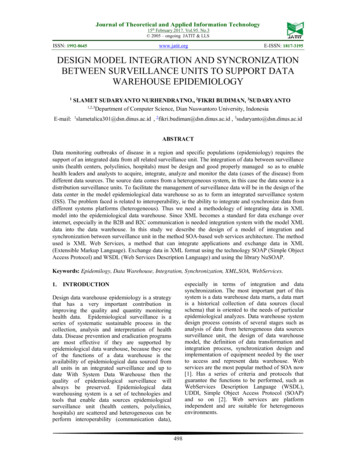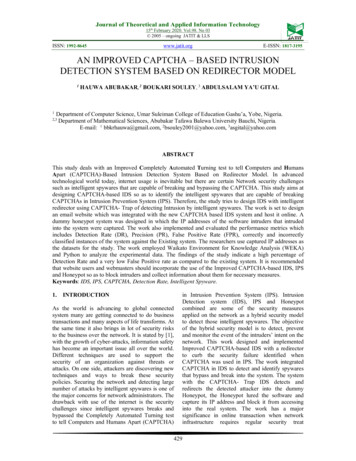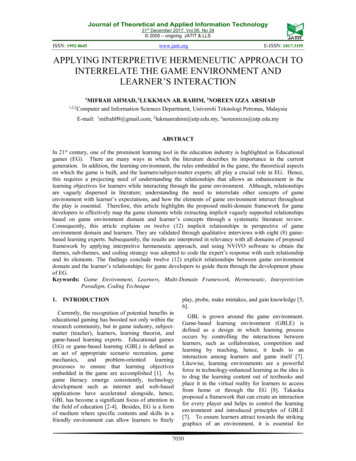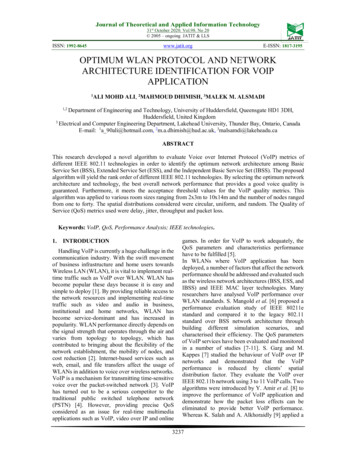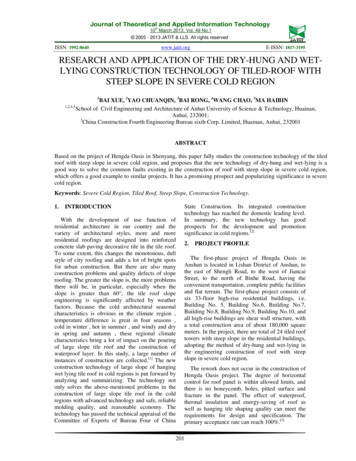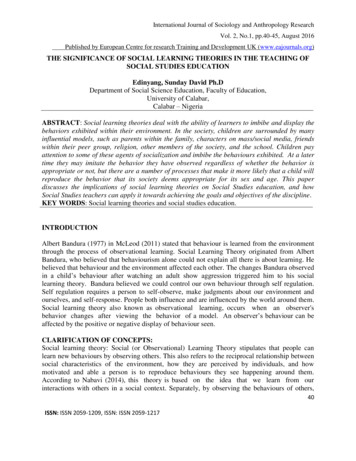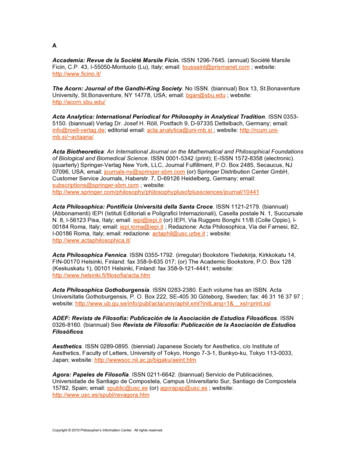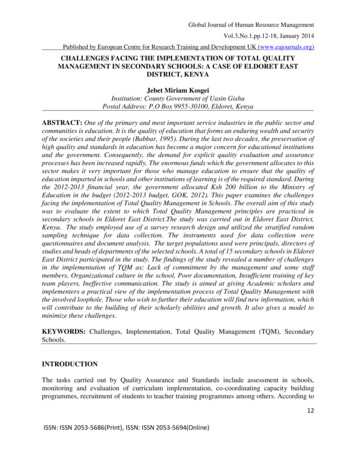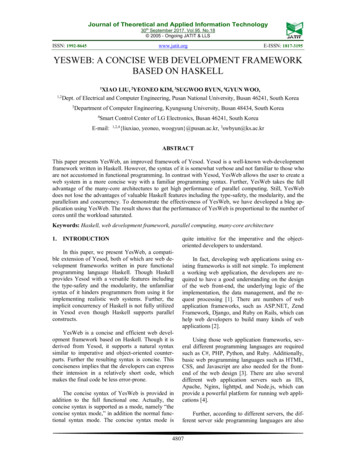
Transcription
Journal of Theoretical and Applied Information Technology30th September 2017. Vol.95. No.18 2005 - Ongoing JATIT & LLSISSN: 1992-8645www.jatit.orgE-ISSN: 1817-3195YESWEB: A CONCISE WEB DEVELOPMENT FRAMEWORKBASED ON HASKELL1XIAO LIU, 2YEONEO KIM, 3SUGWOO BYUN, 4GYUN WOO,1,2Dept. of Electrical and Computer Engineering, Pusan National University, Busan 46241, South Korea3Department of Computer Engineering, Kyungsung University, Busan 48434, South Korea4Smart Control Center of LG Electronics, Busan 46241, South KoreaE-mail:1,2,4{liuxiao, yeoneo, woogyun}@pusan.ac.kr, 3swbyun@ks.ac.krABSTRACTThis paper presents YesWeb, an improved framework of Yesod. Yesod is a well-known web-developmentframework written in Haskell. However, the syntax of it is somewhat verbose and not familiar to those whoare not accustomed in functional programming. In contrast with Yesod, YesWeb allows the user to create aweb system in a more concise way with a familiar programming syntax. Further, YesWeb takes the fulladvantage of the many-core architectures to get high performance of parallel computing. Still, YesWebdoes not lose the advantages of valuable Haskell features including the type-safety, the modularity, and theparallelism and concurrency. To demonstrate the effectiveness of YesWeb, we have developed a blog application using YesWeb. The result shows that the performance of YesWeb is proportional to the number ofcores until the workload saturated.Keywords: Haskell, web development framework, parallel computing, many-core architecture1.quite intuitive for the imperative and the objectoriented developers to understand.INTRODUCTIONIn this paper, we present YesWeb, a compatible extension of Yesod, both of which are web development frameworks written in pure functionalprogramming language Haskell. Though Haskellprovides Yesod with a versatile features includingthe type-safety and the modularity, the unfamiliarsyntax of it hinders programmers from using it forimplementing realistic web systems. Further, theimplicit concurrency of Haskell is not fully utilizedin Yesod even though Haskell supports parallelconstructs.YesWeb is a concise and efficient web development framework based on Haskell. Though it isderived from Yesod, it supports a natural syntaxsimilar to imperative and object-oriented counterparts. Further the resulting syntax is concise. Thisconciseness implies that the developers can expresstheir intension in a relatively short code, whichmakes the final code be less error-prone.The concise syntax of YesWeb is provided inaddition to the full functional one. Actually, theconcise syntax is supported as a mode, namely “theconcise syntax mode,” in addition the normal functional syntax mode. The concise syntax mode isIn fact, developing web applications using existing frameworks is still not simple. To implementa working web application, the developers are required to have a good understanding on the designof the web front-end, the underlying logic of theimplementation, the data management, and the request processing [1]. There are numbers of webapplication frameworks, such as ASP.NET, ZendFramework, Django, and Ruby on Rails, which canhelp web developers to build many kinds of webapplications [2].Using those web application frameworks, several different programming languages are requiredsuch as C#, PHP, Python, and Ruby. Additionally,basic web programming languages such as HTML,CSS, and Javascript are also needed for the frontend of the web design [3]. There are also severaldifferent web application servers such as IIS,Apache, Nginx, lighttpd, and Node.js, which canprovide a powerful platform for running web applications [4].Further, according to different servers, the different server side programming languages are also4807
Journal of Theoretical and Applied Information Technology30th September 2017. Vol.95. No.18 2005 - Ongoing JATIT & LLSISSN: 1992-8645www.jatit.orgbe required. In addition, the SQL is usually required, too, if the web application is supposed tomanage data. Following up all these languages andframeworks required to the front-end and the backend of web applications can be quite timeconsuming for web application developers.On the other hand, how to handle the largescale of requests processing is becoming a hot issuein the web development fields [5]. As illustrated inFigure 1, the number of Internet users has increasedmore than three times in a recent decade, reachingup to more than 3.2 billion, and is still increasing[6].E-ISSN: 1817-3195routing, the data storage, the sessions, and the authentication. YesWeb, as an improved model ofYesod, provides more convenient programmingenvironment than Yesod so that users can create aweb system using a more concise programmingsyntax. All elements of the web application can bedeveloped in only one Haskell source file that cansimplify the file structure.YesWeb also supports the high performance ofparallel computing in many-core architecture thatcan process a large amount of data stream. This is astriking advantage obtained for free owing toHaskell, which has an inherent parallelism and provides several parallel constructs. Both of the frontend and the back-end of a web application can bedeveloped through YesWeb.YesWeb and Yesod take advantage of mostfeatures of Haskell properties such as the static typesystem, both pure and monadic computations, theparallelism with lightweight threads, the datastream processing based on lazy evaluation, etc.[13]. Most of all, the type safety guarantees that aweb application runs in a type-safe manner once itis verified though the compilation, which saves alot of test cost and effort.Figure 1: The increment of the number of Internetusers during the past decades. The number of Internetusers has increased more than three times in a recentdecade.A natural but brilliant approach to make theweb applications process a large quantity of requests from users is adopting the parallelism andconcurrency [7]. The existing web applicationsmentioned above such as Apache can achieve parallel processing and concurrency with the aid of aframework so called Camel [8]. The ISS server alsoprovides parallelism functions for parallel processing [9]. Nginx further supports load balancingon top of the parallelism and concurrency [10].Other servers including Lighttpd also support parallel computing as well [11]. And Node.js supports apackage named node-parallel to implement parallelprocessing, too [12].Yesod includes most features of web components such as website template design, web pageThis paper is organized as follows. Section 2introduces related works such as the features andissues in existing web frameworks, features ofHaskell, Yesod framework and its web servernamed Warp. Section 3 presents the architectureand features of YesWeb framework. Section 4demonstrates an implemented web application thatdeveloped based on YesWeb framework namedYesWeb-Blog. Section 5 presents the parallelismand concurrency of YesWeb-Blog to verify the feasibility, the practicability, and the functionality ofYesWeb framework. Section 6 concludes this work.Section 7 addresses some limitations and futuredirections of the proposed work.2.RELATED WORK2.1 Existing web frameworksWith growth and evolution of the Internet,there are many of web application developmentframeworks such as ASP.NET, Zend Framework,Django, and Ruby on Rails, and many of web servers, such as IIS, Apache, Nginx, and Lighttpd, areintroduced for running web applications [14]. Theseframeworks and servers are wildly used. For example, the BBC website is developed using ZendFramework and Apache server; the Bitbuket is built4808
Journal of Theoretical and Applied Information Technology30th September 2017. Vol.95. No.18 2005 - Ongoing JATIT & LLSISSN: 1992-8645www.jatit.orgon top of the Django framework. Each of theseframeworks and servers has its own features andproblems.ASP.NET is a web application framework developed by Microsoft and ASP stands for ActiveServer Page [15]. ASP.NET inherits the concept ofMVC (Model-View-Controller) which provides anabstractive architecture for data protection and theindependent components resulting a great help forprogrammers to focus more on their own development part [16]. Using ASP.NET framework withthe powerful IDE, the Microsoft Visual Studio, theprogrammers can develop a functional web application with functionalities including the web contentspresentations, request processing, responding, datamanagement, and the security protection [17].However, this famous web application framework, ASP.NET still has several weaknesses andproblems. Firstly, ASP.NET only supports Microsoft Windows operating system well since it isbased on .NET framework. The programmers canonly use the maximal performance of ASP.NET onthe Windows operating system and Microsoft Visual Studio [18]. Secondary, since the mechanism ofASP.NET is on the compile-and-run basis implyingthat it has to compile and run the ASP programover and over to send the HTML file to client‘sweb browser for every time the client send requestto server [19], it consumes lots of time and resources. Last one is the compatibility problem ofweb pages on different web browsers. Many ofbuilt-in web components in ASP.NET frameworkare only runnable on the Internet Explorer browserwhich is also developed by Microsoft, other browsers such like Firefox and Chrome might not be ableto execute those components.Zend Framework is another famous web application framework implemented in PHP 5 [20]. Allthe components of Zend Framework are fully object-oriented, and the loosely coupled use-at-willarchitecture can make the partial modification onweb applications more convenient and easy [21].Zend Framework also supports multiple databasesincluding MariaDB, Mysql, Oracle, Microsoft SQLserver, and SQLite [22]. The wonderful compatibility and portability of PHP makes Zend Frameworkoperate on different operation systems, implyingthat the programmers do not have to be bound on aspecified development environment [23].However, this framework has its own problems, too. Because the complicated componentsE-ISSN: 1817-3195and objects should be loaded every time once thereis a script to be executed [24], Zend Frameworkseems too slow to run a web application whichbased on it. Some of disadvantages inherited fromthe PHP itself is the vulnerability; the external additional files may mess up the file structure of theweb application; the errors will only appear whenthe scripts are executed.Django is a web application framework whichwritten in Python [25]. Different with ASP.NETand Zend Framework, Django has a built-in butstandalone lightweight web server to let programmers test and debug their web applications [26].Django also provides a useful data transition systemthat can easily and conveniently translate data between the HTML forms and the databases [27]. Notonly that, the middleware classes and internal dispatcher system of Django can help programmersdevelop their web applications more quickly. Thisframework can also interact with XML and JSON[28].However, according to Dauzon’s book [29],the server hosts are not allowed to be changed inDjango. A security vulnerability is also discoveredin Django framework, which allows hostile attackon web applications [30]. The disadvantages ofPython also influence the performance of Django,resulting the lower computing performance [31]and the memory management problems due to theoverhead of Python [32].Ruby on Rails is a web application frameworkwritten in Ruby and it follows several valuablesoftware engineering principles such as DRY(Don’t Repeat Yourself) and CoC (Convention overConfiguration) [33]. Since Ruby on Rails is one ofthe famous projects in GitHub, there are lots ofdevelopers working on the improvement of the performance of it [34].However, there are also several technical issuesabout Ruby on Rails. Alex Payne, a developer ofTwitter, criticized the scalability problem of Rubyon Rails [35]. Also, a vulnerability problem on thesecurity of the Ruby on Rails has also been reported, that may reveal cookie information without authentication [36].IIS (Internet Information Services) is a webserver developed by Microsoft and supports manyof Internet protocols such like HTTP, HTTPS, FTP,FTPS, SMTP, and NNTP [37]. There are severalfeatures of IIS such as SNI (Server Name Indica-4809
Journal of Theoretical and Applied Information Technology30th September 2017. Vol.95. No.18 2005 - Ongoing JATIT & LLSISSN: 1992-8645www.jatit.orgtion), dynamic IP address restrictions, and CPUthrottling that are very helpful for developers or foradministrators to deploy and to manage web applications quite comfortably [38].However, like ASP.NET, IIS only supportsMicrosoft Windows operation systems or serverswell. The compatibility problem reduces the portability of IIS and the web application runs on it.Apache is a HTTP server and served as one ofmost popular servers [39]. The URL rewriter module and the virtual hosting function can help programmers to develop and to run multiple web applications without worrying the server distribution.A framework named Camel helps Apache toachieve parallel processing, which can improve therequest processing performance.However, there are many of complicated configurations on Apache when programmers want theApache to fit their web applications. Besides,Apache does not provide a friendly user interface tohelp developers to configure it.Nginx is a web application server which supports the concurrency with low memory usage [40].The reason for Nginx to be able to process morerequests in a unit time with low resource utilizationis the distributed processing. It has a main processto distribute jobs to multiple worker processes [41].Different to Apache, the architecture of Nginx supports the asynchronous event-driven mechanismthat affords to show a certain performance underhigh loads [42].However, Nginx also has its own problems.The ability of Nginx to processing dynamic requests is not quite useful, compared with Apache,Nginx cannot report the problem immediately aftera re-configuration if the configuration file has anyproblem including a simple typo. [43].Lighttpd is a lightweight web application server that has high security and flexibility; it also supports chroot, servlet, and Cache Meta Language[44]. However, Lighttpd has lots of restrictionswhich can make the development process complicated [45].2.2 Parallelism in HaskellHaskell is quite suitable for parallel programming due to its purity of functional programming.As it uses no mutable variables, i.e. no assignmentstatements, every expression has a unique valueE-ISSN: 1817-3195independently in the order of evaluation. From thispoint of view, one can say Haskell has the propertyof natural parallelism.Recent versions of GHC, a Haskell compiler,support several constructs for parallel computation.Its virtual machine manages its own threads independently from OS threads, lightweight thread fork,thread scheduling, and profiling. Using the toolThreadScope, one can analyze graphically the statistics produced from executing programs and debug the parallel performance [46].It is convenient to build parallel programs using the parallel constructs such as par, pseq insource code [47]. The ‘–threaded’ option to tell thecompiler that program is proposed to run concurrently when compiling Haskell code and using‘ RTS –N’ option with the number of cores specifying the maximum number of threads for processing and executing the program. The overheadof GHC threads is extremely low so that GHC isquite powerful in a large amount of event processing. This feature is beneficial in the efficiencyof web applications.2.3 YesodFor web development, Haskell also provides apowerful and convenient web application framework named Yesod. As a web application framework, Yesod includes almost all of necessary webdevelopment tools and technologies such as layoutdesign, function development, and system deploying.Yesod does not require programmers to writeall the HTML, CSS, and Javascript code to print thelayout of the web page. This framework has a template named Shakespearean family to generate allthe source code [48]. Specifically, Yesod supportstemplating languages: Hamlet for generatingHTML code, Lucius and Cassius for generatingCSS code, and Julius for generating Javascriptcode. All of these template languages are quite easyto use, and the type safety of Haskell ensures thatall of the generated code are correct.Warp is an outstanding Haskell web serverused not only for Yesod application but also forother Haskell web applications. Especially theseamless integration of Yesod with Warp makes thebest of performance. Only a little configuration isrequired for deploying and running a web application on Warp, and this convenient approach canreduce lots of time and work.4810
Journal of Theoretical and Applied Information Technology30th September 2017. Vol.95. No.18 2005 - Ongoing JATIT & LLSISSN: 1992-8645www.jatit.orgE-ISSN: 1817-31953. ARCHITECTURE AND FEATURES OFYESWEBAs we mentioned, YesWeb can support its webapplication run on a many-core machine to provideparallelism and concurrency for handling a largeamount of accessing. The YesWeb framework withWarp server and GHC compiler can work togetherto generate web applications. The requests and responses between the client and the web applicationcan be handled after compiling from source codeand running the web application on the server at theback-end.Figure 3: Concise syntax mode of YesWeb, which pro‐vides familiar syntax to imperative and object‐orienteddevelopers.Figure 2 illustrates the three-tier architecture ofYesWeb. The infrastructure layer provides thehardware environment that is a sever consisting of adatabase storage device and many-core processors;the application layer contains YesWeb frameworkand GHC for creating a web application to be runon the Warp server; the client layer allows clients toaccess web application and to use it.YesWeb also provides a concise programmingsyntax mode for the developers who are not familiar with Haskell. The concise syntax is able to generate Haskell code through a code generator.Table 1 presents a comparison among YesWeband other frameworks we mentioned in subsection2.1 and Yesod framework we introduced in subsection 2.3. The comparison result shows that YesWebis advantageous at all facets such as WORA (WriteOnce, Run Anywhere), loading speed, security, andthe conciseness of the syntax.We introduce an example of using the concisesyntax mode of YesWeb in the next Section4.USABILITY TEST OF YESWEB: IMPLEMENTING YESWEB-BLOGAs a usability test of the YesWeb framework,we created a web application named YesWeb-Blog,an online blog application, using YesWeb framework. YesWeb-Blog has the functions such as userauthentication, posting articles and comments. Aswe mentioned, the source code of YesWeb-Blog isdeveloped in only one .hs file that is easy to migrateand maintain, rather than developing web application through other approaches to create various offiles including .html, .js, .css, .php (or other backend scripting source code files).Figure 4: Complex syntax mode of YesWeb, which issimilar to Yesod adopting a full‐fledged functional syn‐tax.We also test the syntax mode of YesWeb in ourweb application. Figure 3 and Figure 4 demonstratethe comparison of the concise syntax mode in YesWeb and the Yesod programming syntax. Figure 3shows the concise syntax code supported in YesWeb. The first line decides the document type asHTML 5; the second line is for setting the URL ofYesWeb-Blog; the third line configures the manager ID of YesWeb-Blog that only the authenticateduser can manage the contents of our web application; the fourth line adds two variables added by themanager for posted articles: article’s title (title) andthe content of article (article). If the developer isfamiliar with Haskell syntax, then the Haskell-likedsyntax mode shown in Figure 4 which is based onYesod is also available for build the same functionsin Figure 3. Comparing the two modes in Figure 3and 4, the YesWeb supports more concise syntaxthan Yesod, which can help developers to buildtheir web application faster.Figure 5 demonstrates how YesWeb-Bloglooks like on a web browser. Once a user clicks thelink (a) shown in Figure 5(1), YesWeb-Blog will4811
Journal of Theoretical and Applied Information Technology30th September 2017. Vol.95. No.18 2005 - Ongoing JATIT & LLSISSN: 1992-8645www.jatit.orgbring the user to the sign in web page shown in (b)of Figure 5(1), which is called from a third-partysystem named Persona. After the authenticationprogress, YesWeb-Blog will show a web page similar to (c) in Figure 5(1). Figure 5(2) shows the testresult for posting an article with a comment from aguest.E-ISSN: 1817-3195Blog in 60 seconds as the number of cores is increasing.With this measurement, we can verify the performance of parallelism and scalability for handlinga large amount of accesses on YesWeb-Blog.The graph in Figure 7 shows two cases: 500and 1,000 concurrent users. YesWeb-Blog processed a similar number of accesses from 500 usersno matter how many cores are processing.However, when there were 1000 users, YesWeb-Blog only was able to process requests onmore than six cores. The numbers of successfullyhandled accesses are also growing from 6 cores to10 cores. This result shows that YesWeb is adaptable and scalable on many core environments.Figure 6: HTML code generated by YesWeb‐Blog forrendering the corresponding web page on web brows‐ers.The entire HTML code for rendering web pages in Figure 5 is presented in Figure 6, which isgenerated through only one Haskell source code filenamed YesWeb-Blog.hs. The HTML code is generated on a web browser when a user accessing ourweb application. Therefore, to migrate the web application to another machine, the only thing wehave to do is move the YesWeb-Blog.hs file to another place then compile and execute it.5.PERFORMANCE OF YESWEB-BLOGFigure 7 presents the benchmark result, thevariation of the throughput of YesWeb-Blog withincreasing the number of cores. We measured thenumber of concurrent hitting times on YesWeb-Figure 7: Performance benchmark evaluated by anHTTP load testing utility named Siege. Two cases areshown in this experiment: 500 concurrent users and1000 concurrent users. Each of the cases are tested 32times from a single core to 32 cores for handling ac‐cesses in 60 seconds.6.CONCLUSIONIn this paper, we proposed a new web application development framework named YesWeb. Developers can use YesWeb in the overall process of aweb application development including the frontend design, data handling, and requests processing.We compared YesWeb with existing web development frameworks. Most of web applicationframeworks and web servers have issues on their4812
Journal of Theoretical and Applied Information Technology30th September 2017. Vol.95. No.18 2005 - Ongoing JATIT & LLSISSN: 1992-8645www.jatit.orgefficiency and compatibility. According to thecomparison result, YesWeb can be a viable alternative to existing frameworks.YesWeb is a compatible extension of Yesodframework to provide more concise programmingsyntax and to archive parallelism and concurrency.The concise programming syntax of YesWeb ismuch productive. To test the effectiveness of YesWeb, we created an implementation of YesWebnamed YesWeb-Blog, an online web blog application, which is written only in 220 lines of Haskellcode.To summarize, the contributions of this workare two folds: YesWeb provides a concise and familiar syntax understandable for imperative and objectoriented developers, yet not losing the valuable features of Haskell YesWeb supports the parallelism to providethe high performance by utilizing the full advantage of parallel machines including manycore architectures.7.LIMITATIONS AND FUTURE WORKThough the performance of YesWeb-Blog isalso satisfactory up to 21 cores of the many-corearchitecture, it needs improvement for more cores.Particularly, the performance of parallel data processing is not growing after more than 10 processorcores. The main reason for this can be the overheadof the run-time system of Haskell.Improving the scalability of parallel data processing of YesWeb can be the most urgent futurework. Though the scalability problem cannot besolved by modifying a single part of the system, wecan try other parallel processing models such asmessage passing models to break the bottle neck ofthe non-increasing scalability on many-core architectures for YesWeb.ACKNOWLEDGEMENTThis work was supported by Institute for Information & communications Technology Promotion (IITP) grant funded by the Korea government(MSIT) (No.B0101-17-0644, Research on HighPerformance and Scalable Manycore OperatingSystem).REFRENCES:E-ISSN: 1817-3195[1] M. Laine, D. Shestakov, E. Litvinova, and P.Vuorimaa, “Toward unified web applicationdevelopment,” IT Professional, no. 5, pp. 30–36, 2011.[2] A. Doup e, B. Boe, C. Kruegel, and G. Vigna,“Fear the ear: discovering and mitigating execution after redirect vulnerabilities,” in Proceedings of the 18th ACM conference on Computerand communications security. ACM, 2011, pp.251–262.[3] J. N. Robbins, Learning web design: A beginner’s guide to HTML, CSS, JavaScript, and webgraphics.” O’Reilly Media, Inc.”, 2012.[4] S.-W. Woo, H. Joh, O. H. Alhazmi, and Y. K.Malaiya, “Modeling vulnerability discoveryprocess in Apache and IIS HTTP servers,”Computers & Security, vol. 30, no. 1, pp. 50–62, 2011.[5] N. Chohan, A. Gupta, C. Bunch, K. Prakasam,and C. Krintz, “Hybrid cloud support for largescale analytics and web processing,” in Proceedings of the 3rd USENIX conference on WebApplication Development. USENIX Association, 2012, pp. 4–4.[6] I. L. Stats. (2015) Number of Internet om/internet-users/,retrieved on 6 June 28, 2017.[7] S. Herhut, R. L. Hudson, T. Shpeisman, and J.Sreeram, “Parallel programming for the web,”in Proceedings of the 4th USENIX conferenceon Hot Topics in Parallelism, HotPar, vol. 12,2012, p. 1.[8] J.-B. Onofré, Mastering Apache Camel. PacktPublishing Ltd, 2015.[9] J. A. Blakeley, P. A. Dyke, C. Galindo-Legaria,N. James, C. Kleinerman, M. Peebles, R.Tkachuk, and V. Washington, “Microsoft SQLserver parallel data warehouse: Architectureoverview,” in Enabling Real-Time Business Intelligence. Springer, 2012, pp. 53–64.[10] X. Chi, B. Liu, Q. Niu, and Q. Wu, “Web loadbalance and cache optimization design basedNginx under high-concurrency environment,” inDigital Manufacturing and Automation(ICDMA), 2012 Third International Conferenceon. IEEE, 2012, pp. 1029–1032.[11] C.-T. Yang, K.-L. Huang, J.-C. Liu, W.-S.Chen, and W.-H. Hsu, “On construction ofcloud IaaS using KVM and Open Nebula forvideo services,” in Parallel Processing Workshops (ICPPW), 2012 41st International Conference on. IEEE, 2012, pp. 212–221.4813
Journal of Theoretical and Applied Information Technology30th September 2017. Vol.95. No.18 2005 - Ongoing JATIT & LLSISSN: 1992-8645www.jatit.org[12] npm. (2013) Node-parallel. [Online]. lel,retrieved on 6 June 28, 2017.[13] G. Hutton, Programming in Haskell. CambridgeUniversity Press, 2007.[14] P. Deitel and H. Deitel, AJAX, rich internet applications, and web development for programmers. Prentice Hall Press, 2008.[15] J. Galloway, P. Haack, B. Wilson, and K. S.Allen, Professional ASP.NET MVC 4. JohnWiley & Sons, 2012.[16] M. MacDonald, Beginning ASP.NET 4.5 in VB.Apress, 2012.[17] A. Freeman, “Your first ASP.NET application,”in Pro ASP.NET 4.5 in C#. Springer, 2013, pp.3–28.[18] A. Freeman and S. Sanderson, Pro ASP.NETMVC 4. Springer, 2012.[19] J. Ciliberti, ASP.NET MVC 4 Recipes: A Problem-Solution Approach. Apress, 2013.[20] B. Porebski, K. Przystalski, and L. Nowak,Building PHP Applications with Symfony,CakePHP, and Zend Framework. John Wileyand Sons, 2011.[21] W. Tan et al., “Online investment and loan application,” 2013.[22] Z. T. Ltd. (2015) Zend database om/manual/1.12/en/zend.db.adapter.html, retrieved on 6 June 28, 2017.[23] Y. Hao, L. Lu, and Y. Zhou, “Design and implementation of enterprise office managementsystem based on PHP,” in Digital Services andInformation Intelligence. Springer, 2014, pp.70–78.[24] I. A. R. Proctor, M. Yang, and H. Zhao, “Executing server side script code specified usingPHP on a server to generate dynamic web pages,” Apr. 22 2014, uS Patent 8,707,161.[25] J. Chou, L. Chen, H. Ding, J. Tu, and B. Xu, “Amethod of optimizing Django based on greedystrategy,” in Web Information System and Application Conference (WISA), 2013 10th. IEEE,2013, pp. 176–179.[26] A. Holovaty and J. Kaplan-Moss, The definitiveguide to Django: Web development done right.Apress, 2009.[27] J. Forcier, P. Bissex, and W. Chun, Python webdevelopment with Django. Addison-WesleyProfessional, 2008.[28] D. S. Foundation. (2015) Django documentation.[Online].Available:E-ISSN: 1817-3195https://docs.djangoproject.com/en/1.8/, retrievedon 6 June 28, 2017.[29] S. Dauzon, Django Essentials. Packt PublishingLtd, 2014.[30] C. Brook. (2013) Security vulnerability inDjango could allow attackers access to ers-access-tocookies/102501/, retrieved on 6 June 28, 2017.[31] V. Bartoš and M. Žádník, “Framework forcomparison of network anomaly detection algorithms,” Technická zpráva FIT-TR-2012-02,Fakulta Informacnıch Technologiı, VUT v Brne,Brno, CZ, 2012.[32] G. Hernandez, R. Leon, L. Salinas, and E. Dimnet, “A fragmentation model with neighborhoodinteraction,” Applied Mathematical Modelling,vol. 36, no. 4, pp. 1694–1702, 2012.[33] M. Hartl, Ruby on Rails Tutorial: Learn WebDevelopment with Rails. Pearson Education,2012.[34] Y. Zhang, G. Yin, Y. Yu, and H. Wan
Zend Framework is another famous web appli-cation framework implemented in PHP 5 [20]. All the components of Zend Framework are fully ob-ject-oriented, and the loosely coupled use-at-will architecture can make the partial modification on web applications more convenient and easy [21]. Zend Framework also supports multiple databases


